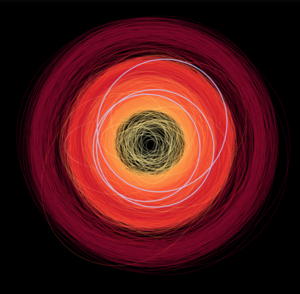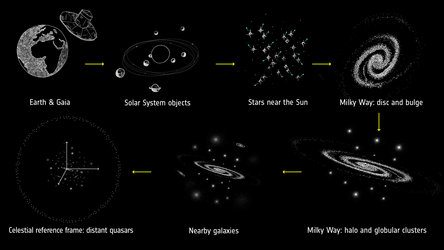Accept all cookies Accept only essential cookies See our Cookie Notice

About ESA
The European Space Agency (ESA) is Europe’s gateway to space. Its mission is to shape the development of Europe’s space capability and ensure that investment in space continues to deliver benefits to the citizens of Europe and the world.
Highlights
ESA - United space in Europe
This is ESA ESA facts Member States & Cooperating States Funding Director General Top management For Member State Delegations European vision European Space Policy ESA & EU Space Councils Responsibility & Sustainability Annual Report Calendar of meetings Corporate newsEstablishments & sites
ESA Headquarters ESA ESTEC ESA ESOC ESA ESRIN ESA EAC ESA ESAC Europe's Spaceport ESA ESEC ESA ECSAT Brussels Office Washington OfficeWorking with ESA
Business with ESA ESA Commercialisation Gateway Law at ESA Careers Cyber resilience at ESA IT at ESA Newsroom Partnerships Merchandising Licence Education Open Space Innovation Platform Integrity and Reporting Administrative Tribunal Health and SafetyMore about ESA
History ESA Historical Archives Exhibitions Publications Art & Culture ESA Merchandise Kids Diversity ESA Brand Centre ESA ChampionsLatest
Space in Member States
Find out more about space activities in our 23 Member States, and understand how ESA works together with their national agencies, institutions and organisations.
Science & Exploration
Exploring our Solar System and unlocking the secrets of the Universe
Go to topicAstronauts
Missions
Juice Euclid Webb Solar Orbiter BepiColombo Gaia ExoMars Cheops Exoplanet missions More missionsActivities
International Space Station Orion service module Gateway Concordia Caves & Pangaea BenefitsLatest
Space Safety
Protecting life and infrastructure on Earth and in orbit
Go to topicAsteroids
Asteroids and Planetary Defence Asteroid danger explained Flyeye telescope: asteroid detection Hera mission: asteroid deflection Near-Earth Object Coordination CentreSpace junk
About space debris Space debris by the numbers Space Environment Report In space refuelling, refurbishing and removingSafety from space
Clean Space ecodesign Zero Debris Technologies Space for Earth Supporting Sustainable DevelopmentApplications
Using space to benefit citizens and meet future challenges on Earth
Go to topicObserving the Earth
Observing the Earth Future EO Copernicus Meteorology Space for our climate Satellite missionsCommercialisation
ESA Commercialisation Gateway Open Space Innovation Platform Business Incubation ESA Space SolutionsEnabling & Support
Making space accessible and developing the technologies for the future
Go to topicBuilding missions
Space Engineering and Technology Test centre Laboratories Concurrent Design Facility Preparing for the future Shaping the Future Discovery and Preparation Advanced Concepts TeamSpace transportation
Space Transportation Ariane Vega Space Rider Future space transportation Boost! Europe's Spaceport Launches from Europe's Spaceport from 2012Latest

What is Gaia?
Thank you for liking
You have already liked this page, you can only like it once!
Gaia is ESA’s mission to create the most accurate three-dimensional map of almost two billion stars throughout our galaxy and beyond, mapping their position, motion, brightness, temperature, and composition. This huge stellar census will provide the data needed to tackle an enormous range of important questions related to the origin, structure, and evolutionary history of our galaxy.
The mission’s additional objectives reveal Gaia as the ultimate discovery machine. It is expected to find thousands of planets beyond our Solar System and to observe hundreds of thousands of asteroids and comets within it. Gaia also observes millions of quasars and other galaxies outside the Milky Way.
Gaia was launched on 19 December 2013 and is placed in an orbit around the Sun, at the second Lagrange point (L2), which is located 1.5 million km from the Earth in the anti-Sun direction. Gaia operates in a Lissajous-type orbit around L2.
At its heart, Gaia contains two optical telescopes that work with three science instruments to precisely determine the location of stars and their velocities, and to split their light into a spectrum for analysis.
During its mission, the spacecraft spins slowly, sweeping the two telescopes across the entire celestial sphere. As the detectors repeatedly measure the position of each celestial object, they detect the object’s motion and any changes in it through space.
Gaia is a fully European mission. The spacecraft is controlled from the European Space Operations Centre (ESOC, Darmstadt, Germany) using the three ground stations Cebreros (Spain), Malargüe (Argentina), and New Norcia (Australia). Science operations are conducted from the European Space Astronomy Centre (ESAC, Villafranca, Spain). Additional scientific staff is located at the European Space and Technology Centre (ESTEC, Noordwijk, Netherlands).
The Gaia Data Processing and Analysis Consortium (DPAC) processes the data to be published in one of the largest stellar catalogues ever made.
-
CREDIT
ESA -
LICENCE
ESA Standard Licence

What Gaia sees outside our galaxy

Gaia’s black holes

Gaia’s first asteroid discoveries

Cosmic scales covered by Gaia’s second data release















 Germany
Germany
 Austria
Austria
 Belgium
Belgium
 Denmark
Denmark
 Spain
Spain
 Estonia
Estonia
 Finland
Finland
 France
France
 Greece
Greece
 Hungary
Hungary
 Ireland
Ireland
 Italy
Italy
 Luxembourg
Luxembourg
 Norway
Norway
 The Netherlands
The Netherlands
 Poland
Poland
 Portugal
Portugal
 Czechia
Czechia
 Romania
Romania
 United Kingdom
United Kingdom
 Slovenia
Slovenia
 Sweden
Sweden
 Switzerland
Switzerland

























